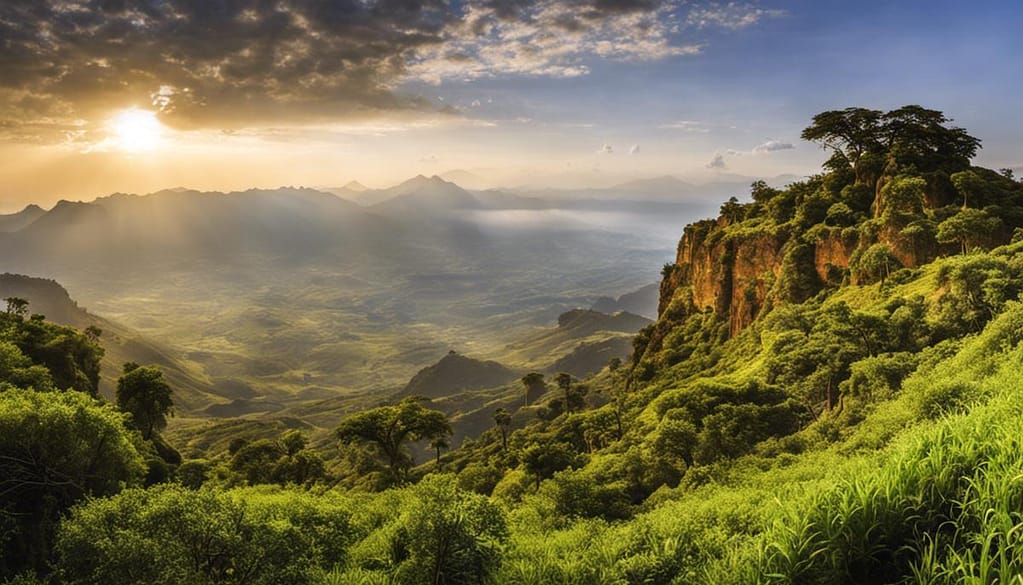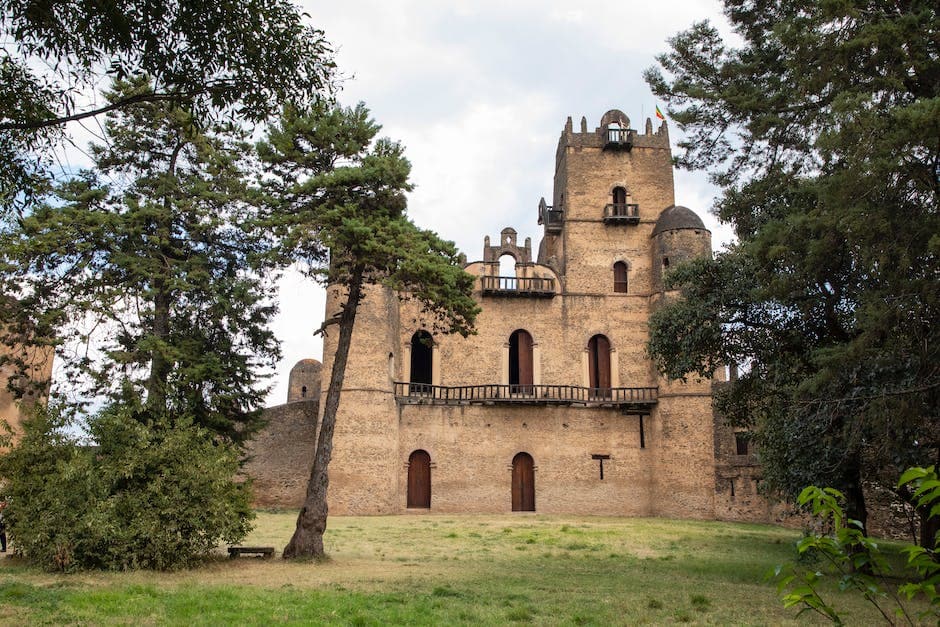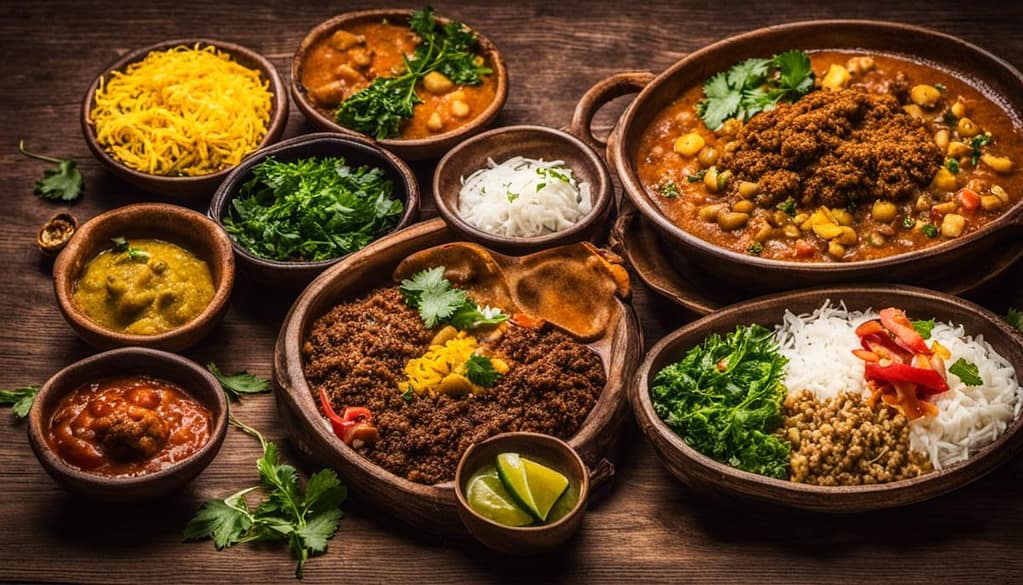Enveloped in a diverse and striking topography, layered with a history that reverberates through the epochs, and drenched in a culture that thrums with vibrancy, Ethiopia offers an immersive and enriching journey that is the heartbeat of Africa. From its majestic summits to its abysmal depths, this comprehensive travel guide threads through the very fabric of Ethiopia, framing its essence in geographical landscapes, historical shades, cultural intricacies, tantalising culinary nuances and practical insights to gracefully orchestrate your Ethiopian expedition.
Understanding Ethiopia’s Geographical Landscape
Discovering Ethiopia’s Topographical Beauty
Ethiopia, the land of origins, is a country characterised by a topographical diversity that is simply breathtaking. From towering peaks and plunging gorges to expansive plateaus and winding rivers, it paints a picture of panoramic beauty that enchants all who visit. The Ethiopian highlands, split by the Great Rift Valley, are dotted with numerous lofty summits, the highest of which is Ras Dashen, reaching a remarkable altitude of over 4,500 metres. The ascent to this great vantage point is a profound experience, offering breathtaking views of the surrounding landscape.
Key Features: Rivers and Lakes
Complementing this mosaic of mountains and plateaus is Ethiopia’s network of rivers and lakes. The mighty Blue Nile, which begins its long journey to the Mediterranean from Ethiopia’s Lake Tana, features the iconic Blue Nile Falls, often dubbed as ‘The Smoking Water’. It is a sight that provides an appealing draw for travellers. The Great Rift Valley is home to numerous lakes, attracting a rich array of birdlife, ideal for wildlife enthusiasts and birdwatchers.
Exploring Ethiopian National Parks
Ethiopia’s natural beauty extends beyond its geographical formations into its diverse wildlife parks. The Simien Mountain National Park, with its spectacular precipices and unique flora and fauna, is among the highlights. This park is especially renowned for being the habitat of the endemic Simien fox and the impressive Walya ibex. The Bale Mountains National Park, another gem, features an intriguing mix of rare and endangered species living amongst its stark mountain landscapes, alpine lakes, and unusual plant life.
Climatic Diversity – Every Season in a Single Nation
The climatic conditions in Ethiopia are as varied as its topography. In the highland areas, the climate is typically cool, with average temperatures rarely exceeding 20°C. However, the lowland areas mostly experience a hot and arid climate, with temperatures often crossing the 40°C mark. Throughout the rainy season, typically from June to September, the country’s landscape takes on a lush green outlook, making it a perfect time for travellers to visit.
In the Lap of Tradition and Culture
The geographical richness of Ethiopia is closely intertwined with its cultural heritage. In the northern highlands, you’ll find ancient Orthodox Christian churches, some of them carved directly out of the rocky mountainsides. Many tribes in the southern Omo Valley still adhere to the traditional way of life, offering visitors a glimpse into their unique cultures and traditions. The cultural heritage, presented in harmony with the country’s geographical beauty, delivers an immersive travel experience that leaves an indelible mark on every visitor’s heart.
Ethiopia Travel Guide – An Adventure Lover’s Paradise
With its diverse landscape offering everything from challenging treks up rugged mountains to relaxed rides down long winding rivers, Ethiopia is a country that beckons adventure seekers from across the world. While the altitude and rough terrains call for physical fitness and preparation, the rewards of fascinating wildlife sightings, spectacular vistas, and exploring harrowing landscapes in an environment that has remained relatively untouched by modern development, are unparalleled.
Standing at the juncture of vibrant wonders and contrasts, Ethiopia unfolds like a captivating story, charming every traveller with her exquisite beauty. Each bend in her road introduces you to a breath-taking view, an awe-striking natural phenomena, or a treasured piece of her timeless cultural heritage. Every corner of this beguiling African country offers something enchanting for those with a keen sense of curiosity.

Ethiopia’s Rich History and Cultural Heritage
The Historical Tapestry of Ethiopia
Ethiopia, one of the globe’s most ancient nations, is a land where humanity’s first steps can be traced back. The region’s history is embodied by ‘Lucy’, a hominid fossil dating back beyond 3 million years, unearthed in the arid stretches of the Afar region. A critical chapter in the country’s historical narrative was the Aksumite Empire, striking a balance between ceasing to exist and scaling new heights of grandeur during 1st to 7th century AD. The legacy of this empire, symbolized by monumental obelisks and mysterious subterranean tombs, echoes through the present-day Ethiopian Orthodox Christianity, particularly prevalent in the northern Tigray region.
Post Aksumite Empire, the torch of sanctity was passed on to the Zagwe Dynasty, which is acclaimed for the miraculous Rock-Hewn Churches of Lalibela, a UNESCO World Heritage site. The succeeding reign of the Solomonic Dynasty, with a lineage link to the revered King Solomon, marked significant strides in shaping the nation’s cultural fabric and political structure. The dynasty is further glorified by the reign of Emperor Menelik II, who forged a symbol of resistance against European imperialism with his triumph in the Battle of Adwa in 1896.
Artifacts and Archaeological Sites
Ethiopia is a treasure trove of artifacts and archaeological sites, offering glimpses into the nation’s past. The National Museum in Addis Ababa houses ‘Lucy’, along with various other Paleolithic exhibits, medieval paintings, and traditional crafts. Other significant artifacts include the Ezana Stone and the Aksumite obelisks, displaying the ancient Ge’ez script. Archaeological sites such as the Tiya Stelae Field, the Yeha Temple, and the Rock-Hewn Churches of Tigray stand as frozen tableaus of a vibrant past.
Cultural Diversity and Unique Traditions
Ethiopia’s cultural diversity is perhaps best evidenced by its more than 80 ethnic groups, each with its unique culture, language, and traditions. The Oromo, Amhara, Tigray, and Somali groups are among the largest. Traditional rituals like the Oromo Gadaa system, a unique democratic socio-political system, the Amhara Meskel festival celebrating the finding of the True Cross, and the Tigray Ashenda, a girls’ festival, are rich expressions of Ethiopia’s cultural wealth.
The music and dance of Ethiopia comprise a colourful mosaic. Whether it’s the rhythmic Eskista dance of the Amhara or the polyphonic singing of the Konso, Ethiopian music and dance reflect the country’s regional and ethnic diversity.
Distinctiveness of Ethiopia: Language, Cuisine, and Unique Aspects
The linguistic landscape of Ethiopia is extraordinarily diverse, boasting over 80 distinct languages. Amharic holds official status, but languages such as Oromo, Somali, and Tigrinya are extensively spoken. Of fascinating note is the ancient language of Ge’ez, currently used solely within the liturgical confines of the Ethiopian Orthodox Church, embodying a profound symbol of Ethiopian heritage.
As for its culinary scene, Ethiopia offers an unmatched gastronomic voyage. The fundamental part of the diet is injera, a type of fermented flatbread, customarily served with a variety of stews known as ‘wot’. The customary beverages range from Tej, a honey-derived wine, to Ethiopian coffee, which is relished with an exclusive coffee ceremony.
Remarkably, Ethiopia follows a unique calendar based on the Coptic system, which lags seven to eight years behind the Gregorian calendar. Furthermore, standing alone among African nations, Ethiopia adheres to a 12-hour clock system that commences at 7 AM. These distinctive aspects, both unacquainted yet mysteriously familiar, heighten the extraordinariness of the Ethiopian ethos, making it an enchanting destination for adventurers and culture enthusiasts alike.

Ethiopia Travel Guide: Major Cities and Attractions in Ethiopia
Addis Ababa: A Blend of Tradition and Modernity
Addis Ababa, the capital of Ethiopia, is an engaging juncture where old meets new. This dynamic metropolis is a melting pot of different cultures, traditions, and architectural styles which seize the interest of visitors from around the globe. Attractions abound, ranging from the National Museum, a treasury of Ethiopia’s historic and cultural heritage which boasts relics such as the olden hominid skeleton named ‘Lucy’, to the bustling Mercato. This lively district is amongst Africa’s most expansive open-air markets and ensures a delightful shopping adventure. The grand Holy Trinity Cathedral, final resting place of Emperor Haile Selassie, and the political and historical hub that is Menelik II square, further offer fascinating insights into Ethiopia’s bygone monarchy.
Lalibela: City of Ancient Wonders
Further north lies Lalibela, a small town renowned for its exceptional rock-hewn churches dating back to the 12th century. Listened as a UNESCO World Heritage site, this ancient city is often referred to as ‘Africa’s Petra’. The churches, carved out of solid rock, are a testament to the ingenuity and devotion of medieval Ethiopian Christianity. Bete Giyorgis or the Church of St. George, built in a cross shape, is a masterpiece that leaves observers in awe.
Aksum: Cradle of Ancient Civilisation
Aksum, another northern city in Ethiopia, carries a deep-seated historical significance. Once the capital of the Aksumite Empire, the city’s archaeological sites depict an advanced and powerful ancient civilisation. The towering granite obelisks or ‘stelae’, one of which is considered the largest single monolithic standing in the world, remains a testament to Aksum’s monumental architecture. The Church of St. Mary of Zion, purported to hold the Ark of the Covenant, is also a vital landmark.
Simien Mountains: A Journey into the Wild
For lovers of nature and adventure, the Simien Mountains provide an exhilarating experience. Located in the northern part of the country, these mountains showcase the breathtaking landscapes of Ethiopia. The rugged terrains, deep valleys, and sheer cliffs make it a paradise for trekking. It’s also a wildlife haven, home to species like the Ethiopian wolf and Gelada baboons.
Danakil Depression: The Alien Landscape
Last, but not least, is the Danakil Depression in northeastern Ethiopia. Known for its alien-like landscape, this geological marvel is among the hottest places on earth. It is renowned for the numerous volcanic activities, crystalline sulphur springs, and salt lakes presenting a kaleidoscope of vibrant colours. A trip to the Danakil Depression is undoubtedly an exploration into a different world.
Discover the Wonders of Ethiopia
Ethiopia offers an unparalleled travel experience, filled with diverse attractions that capture the heart of every visitor. From exploring the bustling city life of Addis Ababa, unearthing the ancient mysteries of Lalibela and Aksum, to immersing in the stunning natural wonders of Simien Mountains and the Danakil Depression, Ethiopia’s uniqueness is undeniable. The richness and diversity of these attractions provide a comprehensive picture of what Ethiopia stands for, creating a complete travel guide, that caters to each inquisitive traveller’s interest.

Practical Information for Travel in Ethiopia
Navigating Visa Requirements
For the majority of foreign nationals, obtaining a visa is a mandatory step prior to travelling to Ethiopia. Options for acquiring a visa range from applying at your local Ethiopian embassy or consulate office, procuring it on arrival at Addis Ababa Bole International Airport, or conveniently securing an e-visa online. The type and duration of your visa will inherently depend on your purpose of visit, which may range from tourism, business, transit to journalism. It’s strongly advised to check the latest visa requirements from your local Ethiopian embassy or the official Government of Ethiopia’s website, as these regulations are subject to change.
Health Precautions
Whether you’re travelling to Ethiopia for a few days or staying for an extended period, it’s important to take some basic health precautions. A Yellow Fever vaccination certificate is required from travellers coming from countries experiencing Yellow Fever. Also recommended are vaccines for Hepatitis A and B, Typhoid, Cholera, and Meningitis. It would also benefit travellers to take anti-malarial medication, especially if visiting low-lying areas such as the Omo Valley. Drink only bottled or boiled water, and bring sunblock, insect repellent and a basic first-aid kit.
Local Customs
Understanding and respecting Ethiopia’s local customs can make or break your visit. Ethiopians appreciate it when foreign visitors show an effort to learn and respect their customs. The Ethiopian Orthodox Church has great influence over daily life, affecting dietary habits, holidays, and dressing codes. It’s expected to dress modestly, especially in religious places. Shoes should be removed when entering someone’s house or a church. Handshakes are customary greetings, done using the right hand or with a bow for elders. Foods are shared from a common plate signifying friendship and hearty meals are a symbol of hospitality.
Getting Around
Ethiopia offers several modes of transportation for locals and tourists alike. Most opted-for are buses and mini-busses for long-distance travel between cities. Inside cities, taxi services are easily available; however, for more adventurous sorts, ‘Bajaj’- auto rickshaws, are popular in many towns. For remote areas, hiring a 4WD vehicle is advisable. Ethiopia also has an extensive domestic flight network, which is an efficient and time-saving way to reach distant places.
Cost of Living
The cost of living in Ethiopia is fairly affordable by Western standards. Accommodations range from budget-friendly hostels to luxury hotels. Meals can also vary, from inexpensive local foods at street markets to more costly international cuisine in high-end restaurants. However, prices outside major cities tend to be significantly lower.
Safety Tips for Ethiopia
Although Ethiopia is relatively safe compared to other African countries, crime can still occur. Pickpocketing and petty thefts are common in crowded places. It is advised to avoid night travels and stay alert in public places. It is also essential not to show off expensive belongings and keep your valuables in a safe place. Political demonstrations are not rare and should be avoided due to potential violence.
Best Times to Visit Ethiopia
The ideal time to visit Ethiopia is during the dry season, between October and February. The weather during this period is moderate with less rainfall, best for outdoor sightseeing. Also, the famous ‘Timket’, the Epiphany festival, occurs in January. However, for bird watchers and nature lovers, the rainy season, from June to September is best for witnessing verdant landscapes and the vast variety of bird species.
Essential Packing Guidelines
When preparing for your visit to Ethiopia, it is wise to pack lightly and intelligently. Given Ethiopia’s notably high altitude, the evenings and mornings can often be quite cool, therefore, it would be prudent to include some lightweight woollens in your luggage. Rainwear, such as waterproof shoes and jackets, along with sun hats are essential items for the rainy season. For visits to religious sites, clothes reflecting modest fashion are crucial. Additionally, consider carrying a universal power adapter, a flashlight, and photocopies of crucial travel documents.

Experience Ethiopian Cuisine
Discover the Flavours of Ethiopian Cuisine
Situated in the vibrant heart of East Africa, Ethiopia presents an array of culinary offerings that are sure to delight your palate. With its deep-rooted traditions and bold, eclectic flavours, the Ethiopian culinary scene caters exceptionally to both vegetarians and meat enthusiasts. Central to this rich cuisine are its unique cooking techniques coupled with the use of bountiful local ingredients.
Signature Dishes
Inarguably, the quintessential standard of Ethiopian dining is Doro Wat, a deceptively simple yet richly layered chicken stew. Doro Wat is prepared using onions simmered over a slow fire, creating a thick spicy sauce called Berbere. This sauce is then combined with chicken and boiled eggs, resulting in a complex dish with strong, bold flavours.
The second staple of Ethiopian cuisine is Injera. This sourdough flatbread accompanies virtually every meal and serves as an edible serving platter. Made from fermented Teff flour, Injera boasts a slightly sour taste which complements the rich, spicy flavours of Ethiopian dishes.
Kitfo, another standout dish, is composed of finely chopped raw beef mixed with Mitmita, a spice blend, and niter kibbeh, a seasoned clarified butter. This dish is often served with Ayibe, a cottage cheese side dish, and Gomen, a collard greens preparation.
Beverages
Beyond food, Ethiopia’s drinks tell a tale of culture and tradition. Tella, a traditional, home-brewed beer made from Teff and barley is a popular beverage often consumed during festivities. Another favourite is Tej, a sweet and potent honey wine.
The coffee culture in Ethiopia is unequalled. As the birthplace of coffee, Ethiopians are renowned for their traditional coffee ceremony. The ritual of washing, roasting, grinding and brewing coffee is an essential social event, symbolising hospitality and respect.
Unique Dining Traditions
Beyond the food and beverages, the methods of dining in Ethiopia are also unique. Eating in Ethiopia is traditionally a communal affair, where food is served on a large Injera and shared among family and friends. The tradition of ‘Gursha’, where one feeds another person as an act of friendship or love, is as ubiquitous as the food itself.
Ethiopian cuisine is extremely inclusive and caters to a variety of diets. In the fasting season, Ethiopian Orthodox Christians observe a vegan diet, which has given birth to a multitude of vegan dishes. Any traveller to Ethiopia, regardless of dietary preferences, is sure to find something delicious to savour.
Ethiopian cuisine breaks the boundaries of usual culinary experiences and invites diners into an entirely unique sphere of tastes, textures, and communal traditions. Succulent stews, hearty breads, native brews, and coffee all hold a prominent place in this endearing food culture. An exploration of Ethiopia’s cuisine offers the rare opportunity to experience a different culture through all five senses.

The vast swathes of Ethiopia lure the intrepid and the inquisitive alike, enticing them with harmonious symphony of spectacular landscapes, historical wonders, cultural extravaganza and culinary delights. This travel guide seeks to unveil the allure of Ethiopia, presenting a prismatic view of what awaits in its belly. With the embers of your curiosity stoked, we hope this guide enables you to write your own Ethiopian saga, one chapter at a time, and take back a piece of Ethiopia imprinted in your soul.

